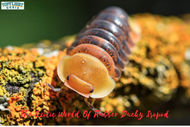Rubber Ducky Isopod Care Guide | TopFlight Dubia
Posted by Ruby Scott on Apr 4th 2024
The Rare & Exotic - Rubber Ducky Isopod
There are over 10,000 identified species of isopods worldwide, but the Rubber Ducky Isopod stands out.
Their appearance is characterized by yellow duck faces and distinct painted tails. They are found in Thailand and belong to the species Cubaris. This relatively new isopod was found in limestone cave areas. Due to their increasing popularity, they are becoming a favorite among exotic pet keepers.
TopFlight Dubia is introducing this detailed guide to provide their habitat conditions, diet plan, and how to care for them properly.
The Distinctive Look
The convex shape of the Rubber Ducky Isopod has a yellow upper body color that sharply contrasts with dark brown patches on the body. These markings act camouflage in their natural habitat, protecting them from predators.
- Body - Segmented
- Exoskeleton - Tough
- Speciality - Natural Mimicry
Here, natural mimicry means that their appearance resembles a yellow duck bath-time toy from a distance, which helps them survive longer than usual.
These isopods are very rare to find, and breeding them in captivity is a challenging task. They also take more time than other isopods to grow and attain maturity.
They quickly roll into a little ball-type figure, replicating their shy behavior. A key observation is that they like to burrow and, hence, can easily hide in the substrate in captivity.
Let’s learn more about pets' natural habitats and how owners can create the best artificial habitats for their pets in captivity.
Habitat - Natural & Artificial
Naturally, they prefer moist environments for surviving.
Originate - Dense and moist leaf litter of tropical rainforests.
Existence - Largely cryptic, staying hidden beneath decaying vegetation or inside the crevices of rotting wood.
These creatures prefer this habitat because their respiratory system's moisture needs rely on cutaneous gas exchange through their pleopodal lungs. Their cryptic lifestyle helps Rubber Ducky Isopods reduce exposure to potential predators.
If a pet owner plans to keep and breed these isopods at home, appropriate capacity is essential for the survival of Rubber Ducky Isopods.
Creating an artificial habitat that is a little moist is essential for these isopods as they offer many microorganisms, which is a crucial part of their diet.
Their artificial environment should replicate their natural habitat. Follow these tips to make their captivity experience as accurate as possible:
- Involve an organic-rich substrate
- Maintain a misting schedule to keep the moisture intact in the habitat
NOTE: A balance of dry and damp areas within the enclosure allows isopods to regulate their moisture needs effectively.
Preparing A Balanced Diet
Making a balanced diet for Rubber Ducky Isopod is a responsibility for any pet owner. Most of the time, these isopods prefer veggie scraps.
Like other creatures of these species, their primary food source consists of decaying wood and leaf litter. Their diet should also include protein sources like dried fish and flake.
ADVICE: Always remove the uneaten food from the enclosure so as not to cause discomfort to the isopod.
The Ideal Substrate
These exotic creatures' substrate is typically a terrarium mixed with added supplements.
RECCOMDATION: Coco fiber with rotting wood and leaves.
Sphagnum moss and pulverized limestone should also be mixed to maintain a higher moisture level. Limestone is added to touch the natural surroundings of the isopod.
Rubber Ducky Isopod uses limestone (calcium carbonate) to build their exoskeletons.
Care For Your Delicate Pet
There are some essential caring tips that a responsible, caring pet owner should always consider:
- Use a hygrometer and monitor the humidity of the enclosure regularly.
- Use the dechlorinated water to mist the enclosure to maintain optimum humidity.
- Incorporating substrate and changing it periodically to keep it fresh is crucial for the health of Rubber Ducky Isopod.
|
CAUTION: A dry environment can lead to desiccation, whereas excessive moisture may cause bacterial and fungal growth. |
The Final Take

Following the suggestions and advice in this TopFlight Dubia guide will keep the Rubber Ducky Isopods happy and healthy enough to breed.
These newly discovered isopods have grown the interest of pet owners worldwide, and keeping them will be a new experience. So, why the wait?
Get the Rubber Ducky Isopods and start your adventurous journey as a pet owner and lover.

